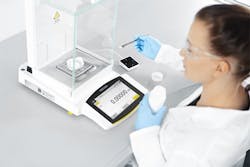Regional Business Manager Lab Weighing, EMEA, Sartorius
Safety, accuracy and reliability are paramount in the development and testing of fine and specialty chemicals. Add to that the need for regulatory compliance, and it becomes clear that proper tools are needed.To understand how lab instruments can complement the process, Chemical Processing spoke with Mitesh Chhana, Regional Business Manager Lab Weighing, EMEA, at Sartorius, a provider of instruments and services for the biopharmaceutical, chemical and food industries.
Q: Why is data integrity important in the production of raw materials for chemical products
and consumer goods?
A: We know that data integrity is important in the pharmaceutical industry. There is also a need for fine chemical producers to concentrate on data integrity because they supply these customers. A lot of companies are now investing in digital solutions. They use electronic lab notebooks (ELN) — Laboratory Information Management Systems (LIMS)— to connect their instruments to manage workflows and get away from paper documentation.
Having correct data also has an impact on how quick companies can increase their discovery or time to market. And the fine chemical and the cosmetic industries are now becoming more and more regulated to be in line with that as they feed into those segments.
Some of the consequences: facilities can be shut down, product recalls — so it’s cost. Delayed drug approvals — again, cost — and loss of reputation, which is obviously priceless as well.
Q: Based on FDA warning letters, what are the most frequent violations made by chemical companies?
A: The majority of warning letters (79%) are attributed to poor data integrity related to access and role management; i.e., who dealt with the data, or the fact that the lab person wasn’t documenting data. The most common example is not implementing controls to ensure that only authorized users can access instruments.
For example, some lab staff are not allowed to use certain instruments if they’re not trained. With some instruments, anyone can use them without any traceability.
An example of role management is having an administrator on the instrument. Without that control, a lab analyst could change configuration settings, or even delete data, which can lead to manipulation that will be picked up at audit.
Another common problem is data that’s not correctly backed up. You need to be able to back up data, all your data, whether it is incorrect or correct from an audit point of view. So, having an audit trail on instruments is key. There are quite a few areas where FDA violations or warning letters [focused] on data integrity.
The Cubis II® allows enhancements in connectivity and data integrity as well as compliance on data handling.
Q: How can organizations minimize these risks and ensure their data integrity?
A: Data integrity starts with having a quality culture within an organization. Some organizations focus on a particular software or a specific instrument, but this brings a risk of forgetting other important systems or causing integrity problems with data exchange between different systems. Therefore, I recommend a top-down approach to identify GxP-relevant processes and then dive deeper into the sub-processes and individual activities with standalone systems and instruments.
You need to make sure that an instrument has all the features to meet FDA 21 Part 11 CFR compliance or the EU Annex 11, which is for electronic instruments. This should include, as prerequisite, an audit trail, user management, electronic signatures, safe data transfer options for integration into further systems like LIMS or ELN. And this further automates the work process and introduces efficiency, time and cost savings, as well as avoiding violations and manual errors, which would have been incurred beforehand.
Q: Are there instruments that offer this?
A: If we look at the laboratory, there is a half and half split between certain instruments that can, and certain instruments that cannot. And this is really down to vendors investing in having the correct control features to support Code of Federal Regulation (CFR) compliance, but also being able to harmonize and complement connecting effectively and compliantly with LIMS and ELN.
A good example would be the Cubis II® balance. It allows enhancements in connectivity and data integrity, as well as compliance on data handling. But the balance was designed to follow the ALCOA (attributable, legible, contemporaneous, original, and accurate) principles, which is the key concept of good documentation practice and contains all the features to support regulation compliance, as well as the other benefits of cost savings and efficiencies that can be gained from handling data in a digitized form.
Q: How does the Cubis II® support good practice adherence?
A: If we were to work in a paper-based fashion versus an electronic fashion, the only thing that really changes in terms of not taking a printout is basically the user interaction; the balance is pretty much the same. What the Cubis II® balance does is it contains all the technical controls to support the compliance, as well as maintaining all the weighing performance features and benefits and applications that were there anyway. There is no need for additional software. It integrates directly into an overarching LIMS or ELN, which most laboratories will have. These features include the comprehensive audit trails and functions for filtering and exporting for convenient review. You can search on a user or a time or a day.
Great for audits and also great for data review. User and role management can be integrated into your company domain, so it’s easy for management, and to support electronic signatures. And one key feature is that we use LDAP (Lightweight Directory Access Protocol), which basically has the same password as you would for all your other Windows passwords within your company. So, it integrates into your IT systems as well, which is fantastic.
Additionally, there are network and time synchronization functions for secure and compliant data transfer. The Cubis II® will give you integration into lab software to a variety of IT interfaces without the need for middleware. This makes things very simple at qualification and reduces operating costs, but maintains compliance. One of the connectivity options featured in Cubis II® is web services. This technology offers bi-directional integration into LIMS and ELN and is very well thought of, especially from a group IT point of view with customers. It makes their life very easy for integration.
Q: How do software applications with guided workflows help achieve trustworthy, compliant results?
A: Guided workflows are the real element that gives you not necessarily the compliant benefits but more the real efficiencies and the time savings, and really does lean up your lab processes. So, automated guided workflows eliminate many steps that can lead to mistakes if you were to do it in a paper fashion. It eliminates the risks of transcription errors, just forgetting simple steps along the way.
The user is guided step by step through a workflow, and the process is specified by standard operating procedures from the balance. The workflow application, also within the balance, guides the user through specific parameters, so it has limits and tolerances that are followed. This not only improves the quality of the data but also brings efficiency and control into the entire lab process, and can reduce a lot of lab costs through rework.
The cost of your materials that you’re using for testing, you’re doing them less because you’re doing them correct more often. Cubis II® brings workflows onto the balance of small applications in the form of QApps (quality assurance project plan), which can be customized, but we have many pre-built and defined QApps to support many weighing applications.
Having a QApp on the balance means there’s no need for additional middleware. We can manage that workflow purely from the balance in a compliant fashion. This allows the user to concentrate on weighing processes, and save space in the lab through not having computers or any additional connectivity required for that.
Q: Are there other balances on the market today that offer digital workflow support without requiring additional software?
A: With regards to within the actual balance, no, this is the only balance on the market that can allow you to maintain full electronic CFR Part 21, Part 11 compliance through all the technical controls it has through audit trail, alibi menu, time synchronization, all these controls are supported within there.
All you have to do is connect to your customer IT LIMS or ELN system. There are other manufacturers that offer middleware, but we often see that it can be quite high effort to implement and integrate another software in between an instrument.
We can go directly into another customer’s overarching laboratory IT system and maintain compliance as well.
Q: Is there anything you’d like to add?
A: We’re now seeing more of a drive in chemical segments. Auditors are asking for good data integrity all the time. From a vendor point of view, the Cubis II® solution makes this task of maintaining or improving data integrity very easy and pain-free task through the integration of our balances into our customers’ IT systems.
Interested in further solutions for your chemical research? Please visit https://www.sartorius.com/chemicals


